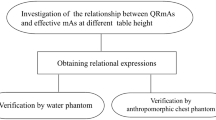Abstract
Automatic exposure control (AEC) is used to optimize the X-ray tube output during computed tomography (CT) scans. However, calculation of the tube current by AEC can be affected when a patient is not aligned with the rotational center of the X-ray tube. An automatic couch height-positioning compensation mechanism provides a corrective function when the patient is off-center. In this study, we aimed to (a) evaluate the performance characteristics of the positioning compensation mechanism and (b) confirm whether our proposed compensation method can be properly applied to a noise-based AEC system even if the CT device is not equipped with a positioning compensation mechanism. An elliptical phantom was scanned at various table heights on systems without/with the positioning compensation mechanism. Expressions describing the offset from the gantry’s isocenter and adjusted standard deviation settings were derived and used in our proposed compensation method. A phantom was scanned at various table heights with our proposed compensation method, and volume CT dose index (CTDIvol) and image noise levels were obtained. An anthropomorphic chest phantom was also scanned using the proposed compensation method to verify its accuracy. When the positioning compensation mechanism was used, it yielded a constant CTDIvol and image noise levels at various table heights tested. A comparison between our proposed method and the positioning compensation mechanism for both the elliptical and chest phantoms yielded similar CTDIvol. Therefore, both automatic and manual positioning compensation methods are useful for avoiding AEC miscalculations in off-centered patient positioning cases.










Similar content being viewed by others
References
Kalra MK, Maher MM, Toth TL, Schmidt B, Westerman BL, Morgan HT, Saini S (2004) Techniques and applications of automatic tube current modulation for CT. Radiology 233(3):649–657
Mulkens TH, Bellinck P, Baeyaert M, Ghysen D, Van Dijck X, Mussen E, Venstermans C, Termote JL (2005) Use of an automatic exposure control mechanism for dose optimization in multi-detector row CT examinations: clinical evaluation. Radiology 237(1):213–223
Furukawa Y, Matsubara K, Miyati T (2020) Inadequate object positioning and improvement of automatic exposure control system calculations based on an empirical algorithm. Phys Eng Sci Med. https://doi.org/10.1007/s13246-020-00949-1
Kawashima H, Ichikawa K, Hanaoka S, Matsubara K, Takata T (2018) Relationship between size – specific dose estimates and image quality in computed tomography depending on patient size. J Appl Clin Med Phys 19(4):246–251
Tack D, De Maertelaer V, Gevenois PA (2003) Dose reduction in multidetector CT using attenuation based online tube current modulation. AJR Am J Roentgenol 181(2):331–334
McMillan K, Bostani M, Cagnon CH, Yu L, Leng S, McCollough CH, McNitt-Gray MF (2017) Estimating patient dose from CT exams that use automatic exposure control: development and validation of methods to accurately estimate tube current values. Med Phys 44(8):4262–4275
Matsubara K, Koshida K, Suzuki M, Tsujii H, Yamamoto T, Matsui O (2008) Comparison between 3-D and z-axis automatic tube current modulation technique in multidetector-row CT. Radiat Prot Dosimetry 128:106–111
Matsubara K, Koshida K, Ichikawa K, Suzuki M, Takata T, Yamamoto T, Matsui O (2009) Misoperation of CT automatic tube current modulation systems with inappropriate patient centering: phantom studies. AJR Am J Roentgenol 192(4):862–865
Toth T, Ge Z, Daly MP (2007) The influence of patient centering on CT dose and image noise. Med Phys 34(7):3093–3101
Saltybaeva N, Alkadhi H (2017) Vertical off-centering affects organ dose in chest CT: evidence from monte carlo simulations in anthropomorphic phantoms. Med Phys 44(11):5697–5704
Kaasalainen T, Palmu K, Reijonen V, Kortesniemi M (2014) Effect of patient centering on patient dose and image noise in chest CT. AJR Am J Roentgenol 203(1):123–130
Oladunni OA, Lauren FA, Rebecca N, Elizabeth AK, Xiangyang T, Pardeep KM, William CS, Courtney CM (2018) Prevalence and severity of off-centering during diagnostic CT: observations from 57,621 CT scans of the chest, abdomen, and/or pelvis. Curr Probl Diagn Radiol 48(3):229–234
Li B, Behrman RH, Norbash AM (2012) Comparison of topogram-based body size indices for CT dose consideration and scan protocol optimization. Med Phys 39(6):3456–3465
Menke J (2005) Comparison of different body size parameters for individual dose adaption in body CT of adults. Radiology 236(2):565–571
Terashima M, Mizonobe K, Date H (2019) Determination of appropriate conversion factors for calculating size-specific dose estimates based on X-ray CT scout images after miscentering correction. Radiol Phys Technol 12(3):283–289
Burton CS, Malkus A, Ranallo F, Szczykutowicz TP (2019) Model-based magnification/minification correction of patient size surrogates extracted from CT localizers. Med Phys 46(1):165–172
Sookpeng S, Martin CJ, Gentle DJ, Lopez-Gonzalez MR (2014) Relationships between patient size, dose size, dose and image noise under automatic tube current modulation systems. J Radiol Prot 34(1):103–123
Acknowledgements
The authors thank the staff in the Department of Radiology Technology, Nagoya University Hospital and Enago (https://www.enago.jp/) for the English language review
Author information
Authors and Affiliations
Corresponding author
Ethics declarations
Conflict of interest
The authors declare no conflict of interest associated with this manuscript.
Human or animal participants
This article does not contain any studies with human participants or animals performed by any of the authors.
Additional information
Publisher's Note
Springer Nature remains neutral with regard to jurisdictional claims in published maps and institutional affiliations.
Rights and permissions
About this article
Cite this article
Furukawa, Y., Matsubara, K. & Tsutsumi, Y. A comparison of automatic and manual compensation methods for the calculation of tube currents during off-centered patient positioning with a noise-based automatic exposure control system in computed tomography. Phys Eng Sci Med 44, 823–832 (2021). https://doi.org/10.1007/s13246-021-01033-y
Received:
Accepted:
Published:
Issue Date:
DOI: https://doi.org/10.1007/s13246-021-01033-y




